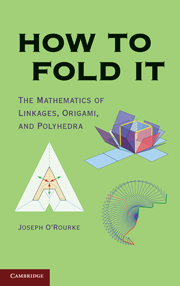7 - Dürer's Problem: Edge Unfolding
Published online by Cambridge University Press: 05 June 2012
Summary
Albrecht Dürer's Nets
In 1525, the German painter and thinker Albrecht Dürer published his masterwork on geometry, whose title translates as “On Teaching Measurement with a Compass and Straightedge.” The fourth part of this work concentrates on polyhedra: the Platonic solids, the Archimedean solids, and several polyhedra “discovered” by Dürer himself. Figure 7.1 shows his famous engraving, “Melencolia I,” in which he used a polyhedron of his own invention a decade earlier. His book presented each polyhedron by drawing a net for it: an unfolding of the surface to a planar layout. The net makes the geometry of the faces and the number of each type of face immediately clear to the eye in a way that a 3D drawing, which necessarily hides part of the polyhedron, does not. Moreover, a net almost demands to be cut out and folded to form the 3D polyhedron. Figures 7.2 and 7.3 show two examples of Dürer's nets. The first is a net of the snub cube, which consists of six squares and 32 equilateral triangles. The second is a net of the truncated icosahedron, consisting of 12 regular pentagons and 20 regular hexagons. We know the spherical version of this polyhedron as a soccer ball.
Dürer's nets, an apparently original representational invention, have since become a standard presentation method for describing polyhedra. For example, Figure 7.4 shows a modern display of nets for the so-called Archimedean (or semiregular) solids.
- Type
- Chapter
- Information
- How to Fold ItThe Mathematics of Linkages, Origami, and Polyhedra, pp. 101 - 118Publisher: Cambridge University PressPrint publication year: 2011



